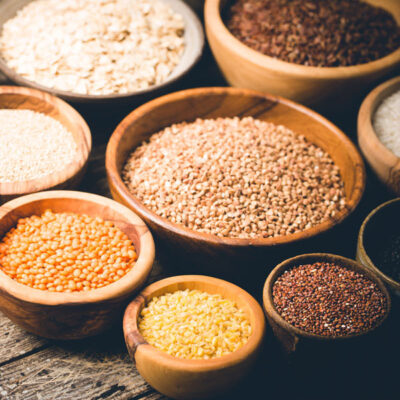Brands
How to Make Gluten Free Flour At Home
By: Admin On: 19 February 2025

Crucial for gluten-free baking. Learn how to make gluten-free flour blends at home with easy steps, versatile ingredients, and practical tips for perfect baking results.
Have you ever felt utterly cheated when you Google a gluten-free baking recipe and the ingredients simply say 'Gluten free flour'? And then usually they go on to mention a specific brand.
If this is you, read on to learn how to make gluten free flour for yourself.
The Cornerstone of Gluten Free Baking
Gluten-free flour is essential for anyone looking to ditch wheat while still enjoying baked goods that taste just as good as the original. Whether you’re avoiding gluten due to allergies, intolerances, or personal choice, your flour selection becomes the backbone of your baking.
Baking with gluten-free flour requires a different mindset. Instead of relying on a single all-purpose flour, you’ll blend various flours and starches to get the right texture and flavour.
But why not just buy a pre-made blend? While commercial mixes are convenient, they’re often expensive and may contain additives or ingredients that don’t suit your needs. Learning to make your own gives you control and flexibility—plus, it’s fun!
What Is Gluten-Free Flour Made Of?
Unlike traditional wheat flour, which balances both starch and protein in one product, gluten-free flour is created by blending multiple ingredients. Each has a particular function—some provide structure, others softness, and a few boost flavour.
Here are the key components you'll typically find in a gluten-free flour blend.
Starches (e.g., potato starch, tapioca starch/flour). These add lightness and texture.
Protein Flour (e.g., brown rice flour, buckwheat flour). These provide body, flavour, and structure to the mix.
A balance of starches and higher protein flours is critical to mimic the elasticity and softness gluten provides in wheat flour.
Now, let's break down the ingredients you’ll need to make your own at home.
Ingredients Needed
Here are the flours and starches you’ll need to craft your basic blend.
White Rice Flour
White rice flour is a versatile and essential component in most basic gluten-free flour blends. Unlike other starches, it has unique qualities that make it irreplaceable in certain applications. It provides the expected softness of a starch whilst the slightly higher protein content contributes a bit more body to recipes. It can however be slightly gritty.
This flour is particularly suited for recipes that require a delicate balance between structure and softness. Its distinct properties make it popular in gluten-free baking, ensuring reliable results when used appropriately. While it works beautifully in some recipes, it’s best to pair it wisely and not substitute it for other starches.
White rice flour contains around 5% protein and 2.5% fibre, with medium water absorption properties. This means that it should absorb a similar amount of water as white wheat flour (although in practice it does tend to require more).
Try our organic white rice flour
Corn Starch or Potato Starch
Corn and potato starch are the main sources of starch used in gluten free flour blends (commercial and homemade).
Starches lend a light and airy quality to cakes and batters and you can use potato starch and cornstarch interchangeably.
Both of these pure starches contain 0% protein and 0% fibre, with low water absorption properties. This means that it does not absorb water very well at all.
Tapioca Flour
As a pure starch, tapioca flour shares similar qualities with cornflour and potato starch. But while these starches are often interchangeable, tapioca flour is used primarily for its ability to add a pleasant chewy texture, which is often missing in gluten-free baked goods. However, it’s worth noting that using too much can result in a bake that feels tough.
Tapioca flour also contains 0% protein and 0% fibre.
Buckwheat Flour
The only true protein flour in our blend, buckwheat is there to lend a slight protein boost and depth of flavour. Known for its unique, nutty flavour, it has an earthy, almost sour taste which needs careful handling.
Due to its higher fibre content, buckwheat is a thirsty flour. However, this also means it doesn't provide much in terms of rise or elasticity, making it less ideal for recipes that rely on structure. To balance this, you can replace a portion of your protein-rich flour with buckwheat flour to enhance both the flavour and the nutritional value of your baked goods.
Buckwheat contains about 13% protein and 13% fibre and has high water absorption properties. This means that it will absorb much more water than wheat flour.
Try our organic buckwheat flour
Now that we have got to know our flours a little better, let's move on.
How to Make Gluten Free Flour
Equipment Needed
Before you get started, ensure you have.
- Measuring cups or a kitchen scale (for precise measurements)
- A large mixing bowl
- Airtight containers for storage
- A whisk or sieve to evenly blend the ingredients
Basic Gluten Free Flour Recipe
Here’s how to create your first gluten-free flour blend.
To start with, we recommend this basic all-purpose blend. As you grow in confidence, you can tweak the proportions and ingredients to create specific blends that match your baking needs.
60% white rice flour
20% potato starch or corn flour
10% tapioca starch
10% buckwheat flour
- Measure Your Ingredients
Use a kitchen scale for accuracy, as consistency is key in baking.
- Add to a Mixing Bowl
Combine your flours and starches in a large bowl. Sift them first if need be.
- Whisk Well
Use a whisk to blend the ingredients evenly.
- Store Properly
Transfer your blend to an airtight container. Label it with the date and contents for easy reference.
Customising Your Flour Blend
Different recipes call for different ratios. Here are some tips on adapting your blend depending on what you’re making.
Cakes
Include more starches (up to 50%) to create a lighter, fluffier texture.
Bread
Use more protein-rich flours like buckwheat or millet to support structure and elasticity.
Pancakes & Muffins
As with cakes, a 50-50 mix of starches and protein flours often works best for softer textures.
You can find out more about working with gluten free flours in our in-depth guide.
Storage Tips
To keep your homemade gluten-free flour blend fresh.
Store it in an airtight container in a cool, dry place, away from direct sunlight.
For longer-term storage, keep it in the fridge or freezer. Just bring it to room temperature before use.
Homemade blends tend to stay fresh for up to three months at room temperature—or six months if refrigerated.
Troubleshooting
Here are some common pitfalls to watch out for.
Gritty Texture?
This can happen if your rice flour isn't fine enough or you haven't allowed for enough water absorption. Rice flour takes a long time to absorb water, and your mix will stiffen in the oven so you won't know about it until it is too late.
Dense Results?
Your mix may rely too heavily on protein flours. Add more starch to lighten it up.
Doesn't Rise Well?
Ensure your recipe includes sufficient raising agents like baking powder or binders such as xanthan gum. These are often needed in gluten-free baking.
If your blend doesn’t perform as expected the first time, don’t be discouraged! Small tweaks can dramatically improve results, and every batch you make will have you learning more.
Why Homemade Gluten-Free Flour Is Worth It
Mastering your flour blend provides benefits that extend beyond baking.
Cost-Effective
Making your own blend costs significantly less than buying pre-packaged versions.
Customised Control
You can adjust the ratio/ingredients to suit specific recipes or personal tastes.
Healthier Choices
You control the ingredients—no unwanted additives or preservatives here.
As we have seen, there are many benefits to making your own gluten free flour blends. It may seem daunting at first to buy four packets instead of one but when used wisely they won't hang around in the cupboard for long and will prove to have far greater versatility than one commercial blend.
Why not take advantage of bulk buy benefits on all of our gluten free flours?






